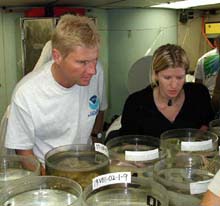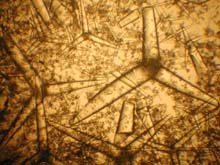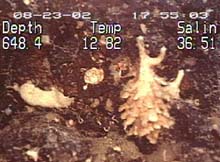I’m Partial to Sponges
August 26, 2002
Shirley Pomponi,
Vice President & Director of Research,
Harbor Branch Oceanographic Institution
For a biologist, one of the most exciting aspects of ocean exploration (other than diving in the submersible, of course) is discovering new species. I remember the first time I saw a living hexactinellid (or “glass”) sponge from the Johnson-Sea-Link. Hexactinellids are sponges that are usually found only in deep water (below 200 m), and until then, the only hexactinellids I had seen were broken samples brought up in dredges, or drawings of what the artist imagined the sponge to look like in life. Neither of these views compared to seeing my first hexactinellid “in the flesh”! This spirit of excitement continues as we dive in unexplored areas and discover species that are new to science.

Dr. Shirley Pomponi examines sponge spicules with her microscope. Click image for a larger view.

Erika Heine and Dr. Eric Warrant examine newly-collected samples. Click image for a larger view.

Microscopic spicules from a pachastrellid sponge. Click image for a larger view.
For example, a few days ago, on a dive just 90 miles off the coast of Charleston, SC, one of our explorers brought up from his sub dive two small brown animals, shaped like Christmas trees. We guessed it was either a sponge or an ascidian (sea squirt), and when we dissected it, we discovered that it was a sponge. On the next dive, I was anxious to find more. (Oh, by now you’ve probably guessed that I’m partial to sponges.) It wasn’t hard to do: we came across a field of literally thousands and thousands of them, growing on small rocks, 600 feet deep. I’ve been diving in the sub for nearly 18 years, and I’ve seen hundreds of different sponges, but I had never seen a sponge like this! When we got to the surface, I examined it microscopically and decided that it was a new species—and possibly even a new genus. When I return to the lab, I’ll review the scientific literature to make sure that it is, indeed, a new species. If it is, the next step will be to write and publish a description of the sponge.
This is just one example of the discoveries we’re making every day. Many of the deep water sponges and corals we’re finding are new—I’d conservatively estimate that we’re finding one new species of marine invertebrate each day on this expedition! And we’re only focusing on the larger animals. Imagine the unique, undescribed biodiversity that’s not visible to the naked eye! When we return to the lab, we’ll begin to work on both the macroorganisms and the microbial samples we’ve collected on our voyage of discovery. No doubt, there will be many more new specie
Interview with Erika Heine, Doctorate Student, Johns Hopkins University and Harbor Branch Oceanographic Institution, studying under Dr. Edie Widder
What are your responsibilities on this expedition?
I have two responsibilities: one is to help Dr. Edie Widder with collections from the submersible and to assist with any problems that arise with the Eye-in-the-Sea camera. My second purpose is to collect dinoflagellates for single cell isolations and measurements of bioluminescence flash kinetics. To do this, I deploy an instrument called the Solid State Bathyphotometer (SSBP) that measures light at depth. From these measurements, I can determine the depth of peak bioluminescence in the upper water column. After teetering this depth, I will target it for plankton net tows, which should allow me to collect potentially bioluminescent dinoflagellates. Once isolated, these dinoflagellates will be stimulated and their bioluminescence recorded.
How did you get interested in this work?
I was enrolled in the Masters Program at California Polytechnic State University, San Luis Obispo. I went on a trip to the Monterey Bay Aquarium Research Institute with my advisor and was introduced to Dr. Steve Haddock’s research on bioluminescent cnidarians. I was so fascinated by the idea of studying bioluminescence in the ocean that I could barely sleep for weeks. After pestering my advisor for months, he put me in contact with Dr. Edie Widder and I went on a cruise with her out of Harbor Branch Oceanographic Institution.
What do you find most interesting about this work?
I am fascinated by the array of organisms that display bioluminescent characteristics. Bioluminescence plays a role in so many aspects of communication in the oceans and there is still so much we do not understand about it. The research possibilities are endless. And the submersible is unbelievably cool!
What do you find challenging about your work?
A lot of times you end up doing a few weeks of field work and months and months of analysis. In order to understand this field, it is necessary to understand biology, chemistry, physics, and engineering. Some of these subjects are more challenging for me than others. It’s also very difficult to be away from my family.
















































